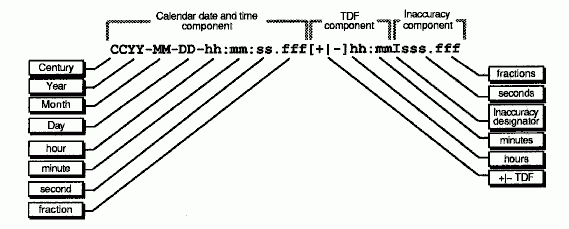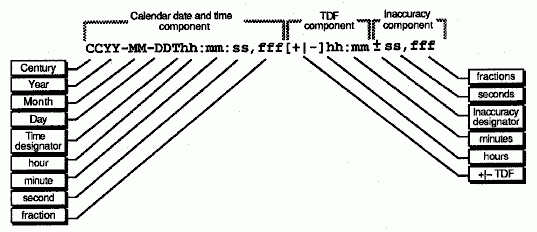
An absolute time is a point on a time scale. For DTS, absolute times reference the UTC time scale; absolute time measurements are derived from system clocks or external time-providers. When DTS reads a system clock time, it records the time in an opaque binary timestamp that also includes the inaccuracy and other information. When you display an absolute time, DTS converts the time to ASCII text as shown in the following display:
1990-11-21-13:30:25.785-04:00I000.082
DTS displays all times in a format that complies with the International Organization for Standardization (ISO) 8601 (1988) standard. Note that the inaccuracy portion of the time is not defined in the ISO standard; times that do not include an inaccuracy are accepted.
The following figure explains the ISO format that generated the previous display.
ISO Format for Time Displays

In this figure, the relative time preceded by the + (plus) or (minus) character indicates the hours and minutes that the calendar date and time are offset from UTC. The presence of this time differential factor (TDF) Time Differential Factor" in the string also indicates that the calendar date and time are the local time of the system, not UTC. Local time is UTC plus the TDF. The Inaccuracy (I) designator indicates the beginning of the inaccuracy component associated with the time.
Although DTS displays all times in the previous format, variations to the ISO format shown in the following figure are also accepted as input for the ASCII conversion routines.
Variations to the ISO Time Format

In this figure, the Time (T) designator separates the calendar date from the time, a , (comma) separates seconds from fractional seconds, and the + or indicates the beginning of the inaccuracy component.
The following examples show some valid time formats.
The following represents July 4, 1776 17:01 GMT and an unspecified inaccuracy (default):
1776-7-4-17:01:00
The following represents a local time of 12:01 (17:01 GMT) on July 4, 1776 with a TDF of -5 hours and an inaccuracy of 100 seconds:
1776-7-4-12:01:00-05:00I100
Both of the following represent 12:00 GMT in the current day, month, and year with an unspecified inaccuracy:
12:00 and T12
The following represents July 14, 1792 00:00 GMT with an unspecified inaccuracy:
1792-7-14